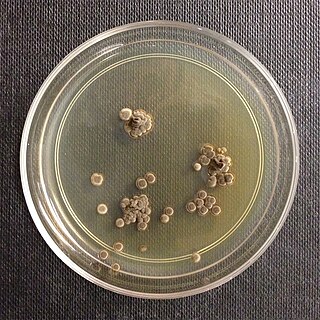Halotolerance is the adaptation of living organisms to conditions of high salinity. Halotolerant species tend to live in areas such as hypersaline lakes, coastal dunes, saline deserts, salt marshes, and inland salt seas and springs. Halophiles are organisms that live in highly saline environments, and require the salinity to survive, while halotolerant organisms can grow under saline conditions, but do not require elevated concentrations of salt for growth. Halophytes are salt-tolerant higher plants. Halotolerant microorganisms are of considerable biotechnological interest.
Chromohalobacter beijerinckii is a motile, rod-like, salt-loving, Gram-negative soil bacterium, 0.4–0.6 μm by 1.8–2.5 μm.
Halopiger is a genus of archaeans in the family Natrialbaceae that have high tolerance to salinity.

The Wallemiomycetes are a class of fungi in the division Basidiomycota. It consists of the single order Wallemiales, containing the single family Wallemiaceae, which in turn contains the single genus Wallemia. The phylogenetic origin of the lineage was placed to various parts of Basidiomycota, but according to the analysis of a larger dataset it is a sister group of Agaricomycotina. The genus contains species of xerophilic molds that are found worldwide. The seven described species are distinguished by conidial size, xerotolerance, halotolerance, chaotolerance, growth temperature regimes, extracellular enzyme activity profiles, and secondary metabolite patterns. They are typically isolated from low-moisture foods, indoor air dust, salterns and soil. W. sebi is thought to be one of the causes of the hypersensitivity pneumonitis known as the farmer's lung disease, but since the other species were recognised and separated from W. sebi only recently, their role in the disease cannot be excluded.
Gracilibacillus is a genus of bacteria within the phylum Bacillota. Species within this genus are generally halotolerant.
Marinobacter persicus is a Gram-negative, non-spore-forming, strictly aerobic and moderately halophilic bacterium from the genus of Marinobacter which has been isolated from the Aran-Bidgol Lake from the central desert of Iran.
Marinobacter shengliensis is a Gram-negative, moderately halophilic, aerobic and rod-shaped bacterium from the genus of Marinobacter with a single polar flagellum, which has been isolated from saline soil which was contaminated with oil from the Shengli Oilfield in China.
Nocardiopsis xinjiangensis is a halophilic bacterium from the genus of Nocardiopsis which has been isolated from saline soil in the Xinjiang Province in China.
Prauserella aidingensis is a bacterium from the genus Prauserella which has been isolated from Aiding Lake in China.
Prauserella alba is a moderately halophilic bacterium from the genus Prauserella which has been isolated from saline soil in China.
Prauserella coralliicola is a Gram-positive bacterium from the genus Prauserella which has been isolated from the coral Galaxea fascicularis from the Luhuitou fringing reef in China.
Prauserella halophila is a moderately halophilic bacterium from the genus Prauserella which has been isolated from soil in Xinjiang, China.
Prauserella muralis is a Gram-positive bacterium from the genus Prauserella which has been isolated from a wall which was colonized with mold in Berlin, Germany.
Prauserella salsuginis is a bacterium from the genus Prauserella which has been isolated from the Aiding Lake in Xinjiang, China.
Prauserella shujinwangii is a Gram-positive, spore-forming and rod-shaped bacterium from the genus Prauserella which has been isolated in Xinjiang, China.
Prauserella soli is a bacterium from the genus Prauserella which has been isolated from crude oil-contaminated soil in Kuwait. Prauserella soli has the ability to degrade crude oil.
Natribacillus is a Gram-positive, moderately halophilic, alkalitolerant, spore-forming, aerobic and motile genus of bacteria from the family of Bacillaceae with one known species. Natribacillus halophilus has been isolated from garden soil from Okabe in Japan.
Pontibacillus is a Gram-positive, spore-forming and strictly aerobic genus of bacteria from the family of Bacillaceae.
Pontibacillus yanchengensis is a Gram-positive, moderately halophilic and aerobic bacterium from the genus of Pontibacillus which has been isolated from soil from the Sanwei salt field from Yancheng in China.
Bounagaea algeriensis is a halophilic species of bacteria from the family of Pseudonocardiaceae. Bounagaea algeriensis has been isolated from saharan soil from El Goléa.
